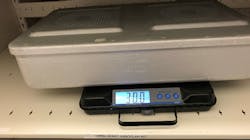Lighten instrument set loads for processing success, staff safety
The density of items placed in an instrument set matters. Imagine 25 pounds of surgical instrumentation evenly spread out across the work surface in the Sterile Processing (SP) assembly area. Now, imagine that instrumentation inside a tray. Because instruments are tightly packed together, there is less surface area in an instrument tray, which creates more mass (density) that can impede successful sterilization.
Association for the Advancement of Medical Instrumentation (AAMI) standards recommend that instrumentation be evenly distributed; however, achieving even distribution can be difficult in the confines of an instrument tray—and there’s the added challenge of having SP staff know how those items should be best arranged in trays/containers.
Historical perspective
In 2006, AAMI recognized that heavier sets could compromise sterilization (rendering the sets unsafe to use) and pose an ergonomic strain for employees. That same year, the association recommended limiting instrument sets’ maximum weight to 25 pounds (this weight limit includes the combined weight of the pan, packaging and the instruments). The following year, AORN’s 2007 Guidance Statement: Safe Patient Handling and Movement in the Perioperative Setting was released with an ergonomic tool that outlined the risks associated with lifting and carrying heavy items such as instrument trays. The guidance was developed in collaboration with ergonomics experts, which included the National Institute for Occupational Safety and Health (NIOSH). NIOSH developed a tool for occupational health and safety professionals to assess the risks associated with lifting and lowering objects within the workplace. A Lifting Index value of 1.0 or less indicates a nominal risk to healthy employees; however, a Lifting Index greater than 1.0 represents indicates a task is high risk for some individuals and can place workers at risk for low-back pain. For that reason, AORN advises caution with lifting tasks that have an index of 1.0 or greater. Many SP leaders and their staff members know of this standard and can articulate the reasoning behind it. Unfortunately, all over the country, instrument sets continue to exceed 25 pounds (sometimes, significantly). Failing to manage instrument set weights places not only the SP and operating room (OR) staff at risk for a work-related injury, but also places patients at greater risk for a surgical site infection (SSI) or other negative outcomes due to the impact heavy sets can have on the sterilization process.
Note from the Healthcare Sterile Processing Association (formerly known as the International Association of Healthcare Central Service Materiel Management): Auditing sets to determine weights and standardizing instrument sets per specialty can help lower set weights by reducing or eliminating instruments that may go unused during the procedure (or allowing extra or frequently unused devices to be placed in a separate container). Loaned instrument sets can also pose a challenge regarding weight; orthopedic sets, for example, can contain dozens of instruments and easily tip the scales at 40 pounds or more. SP professionals should work with their vendors to review set contents and weights and determine how those sets can be broken down into more than one container to make them easier for employees to handle.
About the Author

David Taylor
Principal, Resolute Advisory Group LLC
David L. Taylor, MSN, RN, CNOR is an independent hospital and ambulatory surgery center consultant and the principal of Resolute Advisory Group LLC, in San Antonio, Texas.


